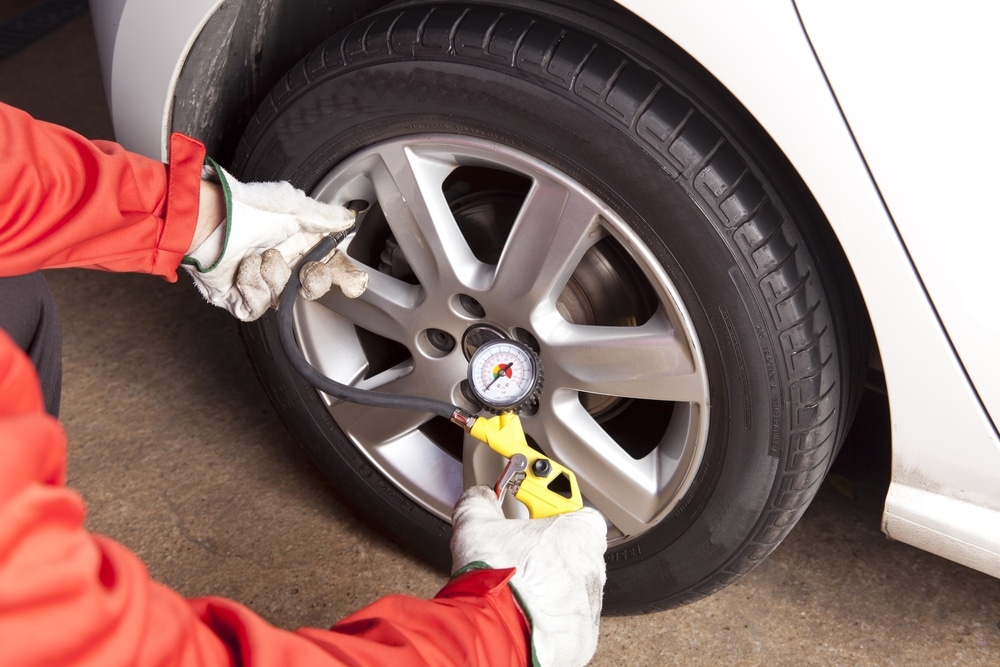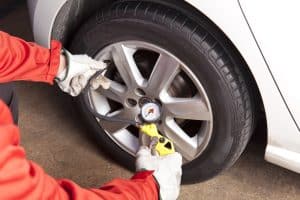
- The Savvy Promise
At Savvy, our mission is to empower you to make informed financial choices. While we maintain stringent editorial standards, this article may include mentions of products offered by our partners. Here’s how we generate income.
In this article
Confused about the different types of car tyres and how to care for them? This comprehensive guide has you covered! Join us as we break down the various tyre options available and delve into essential maintenance tips to maximise tyre lifespan and ensure optimal performance and safety on the road.
What are the different types of car tyre?
There are several different types of car tyres available, each designed to meet specific driving needs and conditions.
- All-season tyres: these tyres are the most common and versatile, designed to provide reliable performance in various weather conditions, including dry, wet and light snow. They offer a balanced combination of traction, durability and comfort for everyday driving.
- Summer tyres: summer tyres are optimised for warm weather conditions, delivering superior grip and handling on dry roads. They often feature a tread pattern designed for enhanced cornering and braking performance at higher temperatures.
- Winter tyres: winter tyres are specifically engineered to provide optimal traction and control in cold weather, snow and ice. They feature specialised rubber compounds and tread designs to grip slippery surfaces effectively, improving safety and stability in winter driving conditions.
- Performance tyres: performance tyres are designed for sports cars, high-performance vehicles and enthusiastic drivers seeking enhanced handling, cornering ability and responsiveness. They offer superior grip and agility but may sacrifice some tread life and comfort for performance.
- Off-road tyres: off-road tyres are built for rugged terrain and challenging off-road conditions. They feature aggressive tread patterns, reinforced sidewalls and durable construction to provide traction, durability and puncture resistance in off-road environments.
- Run-flat tyres: run-flat tyres are designed to allow you to continue driving for a limited distance after a puncture or loss of air pressure, reducing the need for immediate tyre changes and providing added safety and convenience.
- Spare tyres: your car likely comes with a spare tyre, but there are two main types: full-size spare and temporary spare. Full-size spares match your car's regular tyres in size and construction. Temporary spares are smaller and lighter than regular tyres, and meant for temporary use to get you to a repair shop. They often have speed limitations (around 80 km/h).
Understanding the different types of car tyres available can help you choose the most suitable option based on your driving needs, preferences and local weather conditions.
How do I choose the right tyre for my car?
Choosing the right tyre for your car involves considering several factors to ensure optimal performance, safety and value. This includes looking at:
- Tyre size: you should determine the correct tyre size for your vehicle, which can be found in the owner's manual or on the sidewall of your current tyres.
- Driving conditions: consider the climate. Opt for winter tyres for snowy regions, summer tyres for hot climates or all-season tyres for a balance.
- Car type and performance: performance tyres suit sportier vehicles, while all-season tyres offer a balance between comfort and performance for everyday driving. Off-road tyres are ideal for rugged terrain.
- Speed rating and load rating: these markings on the tyre sidewall indicate the maximum safe speed and weight capacity. Ensure they match your car's specifications.
- Treadwear rating: this number indicates the tyre's expected lifespan. Higher ratings suggest potentially longer wear.
- Manufacturer reputation: Research reputable tyre brands known for quality and performance. Consider online reviews for specific models within your budget.
Consider seeking advice from a qualified tyre professional who can guide you based on your car, driving habits and budget.
How do I find out the correct tyre pressure for my car – and why is it important?
The recommended tyre pressure for your vehicle can typically be found in several places such as the owner's manual, inside the driver's side door jamb, on a sticker in the glove compartment or sometimes on the fuel filler flap. It's crucial to adhere to these specifications rather than relying on the pressure listed on the tyre sidewall, as that figure is the maximum pressure the tyre can handle, not necessarily the recommended pressure for your vehicle.
Maintaining the correct tyre pressure is important for several reasons:
- Safety: proper tyre pressure ensures optimal traction, handling and braking, reducing the risk of accidents due to skidding or loss of control.
- Fuel efficiency: correct tyre pressure minimises rolling resistance, improving fuel efficiency by reducing the energy needed to move the vehicle.
- Tyre lifespan: maintaining the recommended tyre pressure promotes even tread wear, extending the lifespan of the tyre and reducing the frequency of replacements.
When should my car tyres be replaced?
There are a few key factors to consider when deciding when to replace your car tyres:
- Tread depth: this is the most crucial indicator. Most tyres have tread wear indicators built into the grooves. These are small, raised bars across the tread. Once the tread surface wears down to the level of these bars (usually around 1.6mm), it's time to replace the tyres. In Australia, the legal minimum tread depth is 1.5mm.
- Tyre age: even if the tread depth seems sufficient, tyres degrade over time due to exposure to heat, sunlight and chemicals. Generally, it's recommended to replace tyres after 6–8 years, regardless of tread wear, to ensure safety.
- Visible damage: regularly inspect your tyres for any signs of damage like cracks, bulges, cuts or foreign objects lodged in the tread. These can compromise the tyre's integrity and warrant immediate replacement.
- Performance issues: Do you notice vibrations in the steering wheel, uneven wear on the tread or reduced handling? These could be signs of tyre problems requiring replacement.
Remember, it's always better to err on the side of caution. If you're unsure about your tyre condition, consult a qualified tyre professional who can inspect them and advise on replacement.
How can I extend the lifespan of my car tyres?
You can extend the lifespan of your car tyres by following these tips:
- Proper tyre maintenance: regularly check tyre pressure, alignment and balance to ensure even wear and optimal performance. Underinflated or overinflated tyres can lead to premature wear and reduced lifespan.
- Rotate tyres regularly: rotate your tyres according to the manufacturer's recommendations to promote even tread wear across all tyres.
- Avoid aggressive driving: limit hard braking, rapid acceleration and sharp cornering, as these actions can accelerate tyre wear.
- Drive smoothly: maintain a steady speed and avoid sudden stops or starts to reduce stress on the tyres.
- Avoid overloading your vehicle: exceeding the recommended load capacity can put excessive strain on the tyres, leading to faster wear.
- Check tyre alignment: misaligned wheels can cause uneven tyre wear. Have your alignment checked regularly and adjusted as needed.
- Avoid driving on rough terrain: rough roads, potholes, and debris can damage tyres. Whenever possible, avoid driving on rough surfaces to prolong tyre life.
- Store tyres properly: if you have spare tyres or seasonal tyres, store them in a cool, dry place away from sunlight to prevent premature aging and deterioration.
By following these practices, you can maximise the lifespan of your car tyres, saving money on replacements and ensuring safe driving conditions.
What should I do if I get a flat tyre?
If you get a flat tyre while driving, follow these steps to address the situation safely:
- Pull over to a safe location: slow down gradually and pull over to a safe spot away from traffic, ideally on level ground. Choose a flat, stable surface to park your vehicle.
- Turn on hazard lights: alert other drivers to your situation by turning on your hazard lights.
- Apply parking brake: ensure your vehicle is secure by engaging the parking brake.
- Assess the damage: inspect the flat tyre for punctures, cuts or damage. If the tyre is severely damaged or the puncture is too large to repair, you may need to install your spare tyre or call for roadside assistance.
- Replace the tyre: if you're comfortable and equipped to do so, follow the steps outlined in your vehicle's manual to replace the flat tyre with the spare tyre. Make sure to use the appropriate tools and follow safety procedures.
- Inflate the spare tyre: check the spare tyre's pressure and inflate it to the recommended level if necessary.
- Drive cautiously: if you've installed the spare tyre, drive cautiously to the nearest tyre repair shop or service station to have the flat tyre repaired or replaced.
- Seek professional assistance: if you're unable to change the tyre yourself or if the spare tyre is not available or suitable, call for roadside assistance for help.
Remember to have your flat tyre repaired or replaced as soon as possible to ensure your vehicle is safe to drive. Regularly inspecting your tyres for signs of wear and damage can help prevent flat tyres and ensure a safe driving experience. It is also important to be prepared by carrying essential tools and equipment, such as a jack, lug wrench and tyre repair kit, in your vehicle.
Choosing the right car tyre is a critical aspect of vehicle maintenance that directly impacts your safety, comfort and driving experience. Your tyres are the only point of contact between your car and the road, so investing time and effort into tyre care and maintenance is essential.
If you're thinking about upgrading your car, Savvy can help! We offer competitive financing options to get you behind the wheel of the car you've always wanted. With flexible loan terms and personalised service, we'll make the financing process smooth and stress-free. Get started with a car loan through us today.
Did you find this page helpful?
Author
Adrian EdlingtonReviewer
Bill TsouvalasPublished on December 7th, 2020
Last updated on March 28th, 2024
Fact checked
This guide provides general information and does not consider your individual needs, finances or objectives. We do not make any recommendation or suggestion about which product is best for you based on your specific situation and we do not compare all companies in the market, or all products offered by all companies. It’s always important to consider whether professional financial, legal or taxation advice is appropriate for you before choosing or purchasing a financial product.
The content on our website is produced by experts in the field of finance and reviewed as part of our editorial guidelines. We endeavour to keep all information across our site updated with accurate information.
Approval for car loans is always subject to our lender’s terms, conditions and qualification criteria. Lenders will undertake a credit check in line with responsible lending obligations to help determine whether you’re in a position to take on the loan you’re applying for.
The interest rate, comparison rate, fees and monthly repayments will depend on factors specific to your profile, such as your financial situation, as well others, such as the loan’s size and your chosen repayment term. Costs such as broker fees, redraw fees or early repayment fees, and cost savings such as fee waivers, aren’t included in the comparison rate but may influence the cost of the loan. Different terms, fees or other loan amounts may result in a different comparison rate.









